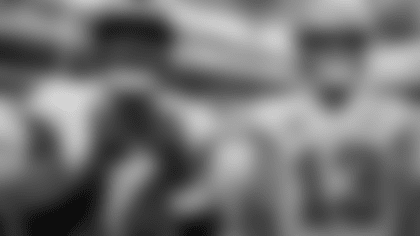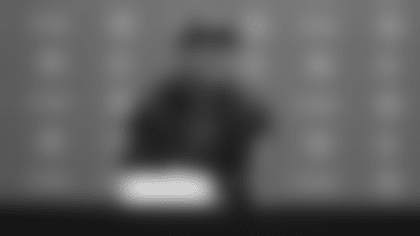Since entering the NFL in 2017, Leonard Fournette has made a habit of wearing his LSU shoulder pads under his Jacksonville and Tampa Bay jerseys. Now he's got a shot at adding another prized element of his college gear to his NFL get-up: his jersey number.
Fournette wore no. 7 during his incredibly productive college career and would have liked to continue doing so after being drafted fourth-overall by the Jaguars in 2017. However, there were two obstacles. First, backup quarterback Chad Henne was already in possession of that number, having worn it for the Jaguars since 2012. Chances are Fournette and Henne could have worked something out, but it was a moot point due to the second obstacle: the NFL wouldn't allow it.
Since 1973, the NFL has had restrictions on the jersey numbers that could be chosen by players at each position. For instance, quarterbacks had to choose something in the 1-19 range. As Fournette found out, running backs were restricted to the 20-49 range, so he went with 27. When Fournette left the Jaguars and joined the Bucs last September, he found 27 already occupied by Ronald Jones so he went with 28. Now he could come full circle to lucky number seven.
On Wednesday, the NFL announced a set of rule changes to take effect for the 2021 season, and one of them was a significant easing of those positional jersey-number restrictions. The league also eliminated overtime in the preseason, because occasionally good and obvious things do happen, and gave the replay official a little more work. Let's take a look at the seven new rules, in order of how interesting they are.
Easing of Jersey Number Positions
These are now the allowed jersey number ranges for each position:
- Quarterbacks, punters and kickers: 1-19 (no change)
- Running backs: 1-49, 80-89 (added 1-19 and 80-89)
- Wide receivers: 1-49, 80-89 (added 1-9 and 20-49)
- Tight ends/H-backs: 1-49, 80-89 (added 1-39)
- Offensive linemen: 50-79 (added 50-59*)
- Defensive linemen: 50-79, 90-99 (no change)
- Linebackers: 1-59, 90-99 (added 1-39)
- Defensive backs: 1-49 (added 1-19)
- Punters and kickers: 1-19 (no change)
(* Centers had already been permitted to wear numbers in the 50-59 range.)
This is good and fun and it's going to be particularly welcome for new players coming into the league. For instance, another LSU player who could go very high in the first round, wide receiver Ja'Marr Chase will now have the option of keeping his college jersey number of 1. Cornerback Patrick Surtain, Jr. can stick with his no. 2 from Alabama, if he so chooses.
Then there are the established NFL veterans like Fournette who may want to change given the new options. (He made it clear in a recent tweet that he definitely does want number 7 back.) The obvious drawback is that any owners of a no. 28 Fournette jersey may feel their gear is outdated, but that seems like an acceptable tradeoff for making so many more coveted numbers available to players in years to come.
Kansas City proposed the rule in order to give teams more flexibility to work around retired numbers. The Chiefs have 10 retired numbers: 3, 16, 18, 28, 33, 36, 58, 63, 78 and 86. Yet right now, even with expanded offseason rosters, the Chiefs have nobody wearing 1, 2, 6, 8, 20 or 21. Now those numbers can go to just about anybody except offensive and defensive linemen. The new rule will certainly help in this regard, but the bigger impact will be ushering in a new generation of receivers, running backs, linebackers and cornerbacks with numbers they've never worn before.
Expanded Input from Replay Officials
It's always risky when the NFL tweaks its replay procedures. The decision in 2019 to make pass interference (and the lack of a pass-interference flag) reviewable, which was a reaction to a blatant mistake in the 2018 NFC Championship Game, proved to be such a disaster that the league mercifully killed it after one year. This one could be tricky, too.
In this case, the Replay Official will now be allowed to communicate "objective" pieces of information to the on-field officials in order to help them get calls right and correct mistakes. This covers such things as if a pass was caught or not, if a turnover was correctly called, whether a ball went out of bounds or not, where a ball should be spotted and whether or not a ballcarrier was down by contact.
What the replay official cannot do is tell the on-field officials to assess a penalty on a team. The replay official is simply now permitted to advise on-field officials on aspects of a play when there is "clear and obvious video evidence." Theoretically, this should lead to fewer mistakes and a better-officiated game, but there are obvious concerns about slowing down the pace of the game and potentially not taking the idea of a "sky judge" far enough.
Elimination of Overtime in the Preseason
Well, maybe this isn't one of the more interesting rule changes, but it is definitely one of the most welcome. Nobody wants overtime in the preseason. Fans, coaches, players, broadcasters, groundskeepers – nobody. And nobody cares if a preseason game ends in a tie. Quick: Tell me the Buccaneers' preseason record in 2019.
Coaches want two and only two things out of the back half a preseason game: to evaluate some younger players and to get out of their healthy. Since the outcome of a preseason game has no bearing on the playoff chase, there's no reason to expose any players to added injury risk in a fifth period.
Reduce Players in the 'Setup Zone' to Increase Onside Kick Recoveries
This is an attempt to balance out the effects of last year's rule change that eliminated the running starts for the kicking team. That was a safety measure as the league continues to try to make the kickoff safer without eliminating it completely from the game. It had the added effect of making it significantly harder for an onside kick to be pulled off successfully.
So, after placing a restriction on the kicking team, the NFL is now doing the same to the receiving team. The 'setup zone' for the receiving team starts 10 yards from the kicking line and extends 15 yards downfield, and under the recently-tweaked rules a team had to have at least eight of their 11 players in this area at the kick. When a receiving team was expecting an onside attempt it could put 10 or even all of its players in that area if it so chose.
Now the receiving team will be permitted to keep a maximum of nine players in the setup zone, giving them one fewer set of hands on the front line during an onside kick. It's hard to say if this will be enough of a change to make any real difference in onside kick results, but that is why it's a test. This rule change has only been adopted for one season; it would need to be adopted permanently next year if the league wants to stick with it.
Loss of Down for an Illegal Second Pass
The most interesting thing about this rule is that you essentially have Tom Brady to thank (or blame) for it.
In last year's Week 11 game between the Rams and Buccaneers, Brady had a pass batted back to him nine yards deep in the backfield. He caught and immediately fired off another pass that Mike Evans caught for eight yards. That was an obvious penalty – only one forward pass from the behind of line of scrimmage is allowed on any play – and it was indeed flagged. However, since Evans was short of the first down the Rams declined and the Bucs punted.
So it was no coincidence that the Rams proposed this rule. Had Los Angeles accepted that penalty at the time, the Bucs would have lost yardage but it would have still been third down, so they elected to make it fourth down instead, correctly expecting the Bucs to punt from their own 32 yard line. With this rule now in place, accepting the penalty would have pushed the Bucs back five yards and enforced a loss of down, making it fourth-and-15. Still a punt but now a loss of yardage as well.
Again, this one seems like common sense. A team shouldn't benefit from breaking a rule, inadvertently or not, and the Bucs got eight yard here they wouldn't get now.
Enforcement of All Accepted Penalties on Successive Extra Point Tries
You may watch a whole lot of games before you see this come into play, and you may not even know it's happening when it does. I won't pretend this one is interesting.
Basically, it's closing another loophole like the one above. Imagine a team choosing to go for a two-point attempt and committing a 10-yard penalty. Now that it is 12 yards away, it changes its mind and decides to kick the extra point. This time, the defending team commits a penalty. Due to the way the rule is worded, at this point the kicking team would have the option of going to the yard line of the other type of try (the two-point attempt) and switch back to going for two. Now, logically, the yardage of both penalties will be enforced, rather than the ball going back to the two-yard line.
Fine, makes sense. I think I already forgot about it. This one was submitted by the Chicago Bears, so presumably this happened to them one time and it made them mad.



































